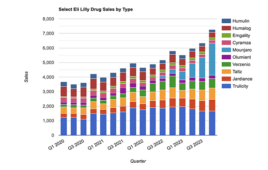Neil Canavan
Contributing Editor
New animal models show that there is more than one way to test a bug, which might just get scientists closer to understanding infection in humans.
Television has taught us in the last few years that there is a limitless supply of human beings willing to eat, perform, or otherwise endure the most unpleasant things on earth for cold, hard cash. Yet, almost inexplicably, these same stunt-junkies shy away from nearly all forms of basic medical research; it is here, in the land of hidden knowledge that the animals rule, and here, where lions are never seen, that the squeaky mouse is king.
In recognition of this fact, in September 2006, the National Institutes of Health (NIH) launched the extraordinary initiative with the diminutive name: the Knockout
 click to enlarge A Medaka fish infected with Mycobacterium marinum as seen under fluorescent imaging. (Source: Donald G. Ennis, PhD) |
Mouse Project (KoMP). The goal of the program, in conjunction with Canadian and European counterparts, is to build, and make publicly available, knockout models for every gene in the murine genome. With $52 million available to flesh out its contribution, the NIH has already awarded a sizable grant to Regeneron Pharmaceuticals, Tarrytown, N.Y., to fuel its innovative, mouse-making efforts.
The first innovation, called VelociGene, was reported in 2003 by lead investigator David Valenzuela, PhD, vice president of genomics and bioinformatics at Regeneron. “We basically broke the sound barrier of making a mouse knockout,” says Valenzuela, “Before that, making a knockout was a one-to-one, custom-made effort, often done by a postdoc and taking the better part of a year. We made possible the industrialization of the process.”
To accomplish this, Valenzuela abandoned the traditional gene-trap approach, a technique of gene disruption that is: 1) random, and 2) dependent on gene expression within the embryonic stem (ES) cell. He created instead a method in which targeted vectors disrupt not random genes, but genes of interest; is not dependent on ES gene expression; and, by using bacterial artificial chromosomes as vectors, could be done in a high-throughput fashion. This approach worked so well, and so quickly, that a second innovation was required to address the bottleneck in production: the making of the actual mouse.
“Traditionally, what people do is take the [altered] ES cells and microinject them into a blastocyst of 64 to 128 cells and then (several steps later) what you get is an animal, a chimera, made up of a mix of host and injected ES cells.” This generation is F0. These chimeric mice are backcrossed with wild-type mice to obtain first-generation progeny (F1) that are heterozygous for the transgene, then the heterozygotes are crossed to get second-generation progeny (F2) homozygotes, which is the generation that can be used for research.
The process is time-consuming, tedious, and has iffy outcomes; Valenzuela wanted to avoid it. “We injected not into the blastocyst—which already has the inner cell mass—but an earlier stage where the inner cell mass has not yet formed.” This gambit resulted in an F0 mouse that can go straight into research. “These animals are not chimeras. They’re fully derived from the ES cells to a point where you can actually get the phenotype in the first generation.” Valenzuela expects to produce hundreds, if not thousands, of knockouts within the year.
Mouse-bound
Turning from hoards of mice to a special mouse, Michael Starnbach, PhD, Department of Microbiology and Molecular Genetics, Harvard University, Boston, has taken a new approach to the
 |
study of the sexually-transmitted disease caused by Chlamydia trachomatis. “In the past we’ve studied T-cell responses to these infections by infecting animals systemically with strains of Chlamydia. We’ve infected them intravenously or intraperitoneally with an organism that, in humans, causes a disease in the genital tract or in the conjunctiva: It’s a mucosal infection.” So, this posed a dilemma for Starnbach, who was trying to elucidate the body’s specific T-cell response—the component of the immune system previously known to have a protective activity against Chlamydia at the real-world site of infection. Information derived from systemic T-cells, genital tract etc., was simply inadequate, and enhancement methods used in related studies wouldn’t work for this bug.
“In other pathogen systems,” says Starnbach, “T-cell receptor (TCR) transgenic mice have been developed against model antigens, things like ovalbumin. You could then take the ovalbumin protein and engineer it into an organism that you might wish to study.” But with Chlamydia this approach is not possible. “Either Chlamydia is not modifiable,” says Starnbach, “or we don’t yet have the system to modify it genetically. So, we had to identify the specific T-cell that can recognize Chlamydia antigens and then, to create these mice, we had to clone that specific T-cell receptor.” Once done, transgenic animals expressing the Chlamydia-specific TCR were created, and labeled preparations of purified T-cells were then injected into Chlamydia-naïve mice, where a new infection could now be tracked.
“The result is we can infect these animals with Chlamydia in the genital tract—a more reasonable representation of what goes on during human infection—and follow the T-cell response to the initial encounter with the organism.” As data from this new
| Fishin’ for TB In his quest to find the right animal model in which to study Mycobacterium tuberculosis infection, Don Ennis, PhD, associate professor of biology at the University of Louisiana, Lafayette, had to work around at least two problems. First, mice don’t get TB. “The mouse is not a natural host of that pathogen,” says Ennis. “They can be infected, but the disease is not the same as it is in people.” Fish, on the other hand, do get TB-like infections from the closely-related pathogen, Mycobacterium marinum, but the standard fish model, zebra fish,get too sick. “It’s an acute infection in zebra fish, whereas in humans TB is chronic—less than 1% of people infected with TB in the world are actually exhibiting serious overt symptoms.” So, that’s where medaka came in. “A lot of people don’t know that medaka has had more than 50 years of basic science done in Japan,” says Ennis, “And once we took a look, we found “That means we can infect with our bacteria—which we’ve engineered to express green fluorescent protein—and then monitor the infection in real time; we get a chronically infected fish whose different organs are absolutely glowing.” What Ennis now hopes to do is treat his fish with a battery of antibiotics and ask: Where do the lights stay on? This is critical for TB, an infection that can notoriously linger. “We suspect that where the lights stay on, those are the |
approach are accrued, and other Chlamydia antigens are tested, Starnbach is hopeful that the end result will be the components for what will constitute a Chlamydia vaccine. “The real value to vaccines is to be able to understand what kinds of responses actually work and are protective.” This model will shine light on the most effective guardians.
Mouse lights
A downside to Starnbach’s approach is that the animals must be sacrificed for the tissue to be imaged. A new technology from Caliper Life Sciences, Hopkinton, Mass., may render that step unnecessary. Recently validated in a model of Proteus mirabilis infection, Kevin Francis, PhD, director of technical applications for Caliper, describes his method and its advantages, “What biophotonic imaging allows you to do is monitor and track the progress of infectious disease in animals; you can monitor gene expression, and you can monitor the pathologies as they unfold in the animal in real-time.”
Most imaging modalities just look at static points in disease progression—gross morphological changes—whereas with biophotonic imaging, one can actually see when a gene is switched on in a pathogenic pathway as the infection takes hold. This feat is accomplished by using the proprietary IVIS Spectrum optical imaging device, and any number of readily available fluorescent tags.
“The number of markers that you can put into a system, tagging both pathogen and animal, are quite large now,” says Francis, there are luciferases, dyes, fluorescent antibodies, and even quantum dots. Given such an array of light emissions it’s possible to take a multi-dimensional look at the milestones of infection. “You can look at pathogen activity, or you can look at it from the host perspective,” says Francis.
For instance, you can determine whether a pathogen is switching on a particular host-cytokine pathway. “This is where you make transgenic ‘knock in’ animals so you can then watch the cross-talk between the pathogen and the animal.” And all this can be done non-invasively, with images that can be collected for up to five minutes, from an animal that can then be returned to its cage. This is of particular value for pathogens that have a complex life cycle, which may be more easily druggable at different time points. It is also a great way to monitor a mouse who, sitting back in his cage, hopes one day to be cured.
About the Author
Neil Canavan is a freelance journalist of science and medicine based in New York.
This article was published in Drug Discovery & Development magazine: Vol. 10, No. 4, April, 2007, pp. 32-35.
Filed Under: Drug Discovery




